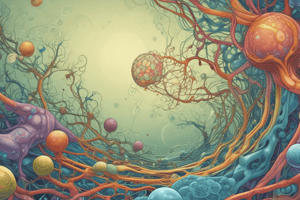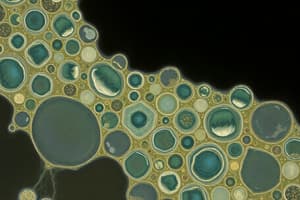Podcast
Questions and Answers
Which statement about prokaryotic cells is true?
Which statement about prokaryotic cells is true?
- They are larger and more complex than eukaryotic cells.
- They have a nucleus.
- They lack a nucleus and have a simpler structure. (correct)
- They contain membrane-bound organelles.
What is one primary function of the mitochondria in a cell?
What is one primary function of the mitochondria in a cell?
- Synthesizes lipids.
- Dissolves waste materials.
- Produces ATP. (correct)
- Modifies proteins.
Which of the following is NOT a function of the cell membrane?
Which of the following is NOT a function of the cell membrane?
- Facilitates communication and signaling.
- Maintains cell shape.
- Provides energy for the cell. (correct)
- Regulates entry and exit of substances.
How does meiosis differ from mitosis?
How does meiosis differ from mitosis?
Which organ system is directly responsible for gas exchange in the body?
Which organ system is directly responsible for gas exchange in the body?
What role do hormones play in the endocrine system?
What role do hormones play in the endocrine system?
What is homeostasis?
What is homeostasis?
Which type of muscle is involuntary and found only in the heart?
Which type of muscle is involuntary and found only in the heart?
Flashcards are hidden until you start studying
Study Notes
Cell Biology
-
Cell Theory:
- All living organisms are composed of cells.
- The cell is the basic unit of life.
- All cells arise from pre-existing cells.
-
Cell Structure:
- Prokaryotic Cells: Lack a nucleus, smaller, simpler structure (e.g., bacteria).
- Eukaryotic Cells: Have a nucleus, larger, complex structure (e.g., plant and animal cells).
- Organelles:
- Nucleus: Contains genetic material (DNA).
- Mitochondria: Powerhouse of the cell, site of ATP production.
- Endoplasmic Reticulum (ER):
- Rough ER: Studded with ribosomes, synthesizes proteins.
- Smooth ER: Synthesizes lipids, detoxifies substances.
- Golgi Apparatus: Modifies, sorts, and packages proteins and lipids.
- Lysosomes: Contain digestive enzymes for waste breakdown.
-
Cell Membrane:
- Structure: Phospholipid bilayer with embedded proteins.
- Functions: Regulates what enters and exits the cell, communication, and signaling.
-
Cell Division:
- Mitosis: Process of somatic cell division; results in two identical daughter cells.
- Meiosis: Process of gamete formation; results in four genetically diverse cells.
Human Physiology
-
Organ Systems:
- Circulatory System: Transports blood, nutrients, gases, and waste; includes heart and blood vessels.
- Respiratory System: Facilitates gas exchange; consists of lungs, trachea, and diaphragm.
- Digestive System: Breaks down food into nutrients; includes mouth, stomach, intestines, and liver.
- Nervous System: Controls body functions through signals; includes brain, spinal cord, and nerves.
-
Homeostasis:
- Definition: The maintenance of a stable internal environment.
- Mechanisms: Feedback loops (positive and negative) regulate body functions (e.g., temperature, pH).
-
Muscle Types:
- Skeletal Muscle: Voluntary, striated, and attached to bones; responsible for movement.
- Cardiac Muscle: Involuntary, striated, found only in the heart; pumps blood.
- Smooth Muscle: Involuntary, non-striated, found in walls of hollow organs (e.g., intestines, blood vessels).
-
Endocrine System:
- Composed of glands that secrete hormones.
- Hormones regulate growth, metabolism, and reproductive processes.
-
Immune System:
- Defends against pathogens.
- Includes white blood cells, antibodies, and lymphatic system.
-
Excretory System:
- Removes waste products from the body.
- Key organs: Kidneys, ureters, bladder, urethra.
Cell Biology
-
Cell Theory outlines three fundamental principles: all living organisms are made of cells, cells are the basic unit of life, and new cells arise from existing cells.
-
Prokaryotic Cells characterize organisms like bacteria; they lack a nucleus and are typically smaller and simpler.
-
Eukaryotic Cells include more complex organisms like plants and animals; they contain a well-defined nucleus.
-
Organelles have specific functions within eukaryotic cells:
- Nucleus houses DNA and regulates gene expression.
- Mitochondria are the site of ATP production, providing energy for cellular activity.
- Endoplasmic Reticulum (ER) has two forms:
- Rough ER is covered with ribosomes, essential for protein synthesis.
- Smooth ER synthesizes lipids and detoxifies harmful substances.
- Golgi Apparatus functions in modifying, sorting, and packaging proteins and lipids for secretion or use within the cell.
- Lysosomes contain digestive enzymes to break down waste materials and cellular debris.
-
Cell Membrane consists of a phospholipid bilayer with embedded proteins, crucial for regulating the passage of substances into and out of the cell, and facilitating communication.
-
Cell Division occurs through:
- Mitosis: yields two identical daughter cells for growth and repair.
- Meiosis: generates four genetically diverse gametes for reproduction.
Human Physiology
-
Organ Systems work together to maintain bodily functions:
- Circulatory System encompasses the heart and blood vessels, vital for transporting blood, nutrients, gases, and waste.
- Respiratory System includes lungs and trachea, enabling gas exchange for oxygen and carbon dioxide.
- Digestive System involves the mouth, stomach, intestines, and liver, breaking down food into absorbable nutrients.
- Nervous System consists of the brain, spinal cord, and nerves, coordinating body functions through electrical signals.
-
Homeostasis refers to the body's ability to maintain a stable internal environment, regulated through feedback loops to control variables like temperature and pH.
-
Muscle Types are categorized based on their structure and function:
- Skeletal Muscle: Voluntary control, striated appearance, attached to bones for movement.
- Cardiac Muscle: Involuntary, striated, unique to the heart, responsible for pumping blood.
- Smooth Muscle: Involuntary, non-striated, occurs in walls of hollow organs like intestines and blood vessels.
-
Endocrine System comprises glands that secrete hormones, influencing growth, metabolism, and reproductive functions.
-
Immune System provides defense against pathogens, involving white blood cells, antibodies, and components of the lymphatic system.
-
Excretory System is responsible for waste removal, key organs include kidneys, ureters, bladder, and urethra.
Studying That Suits You
Use AI to generate personalized quizzes and flashcards to suit your learning preferences.




